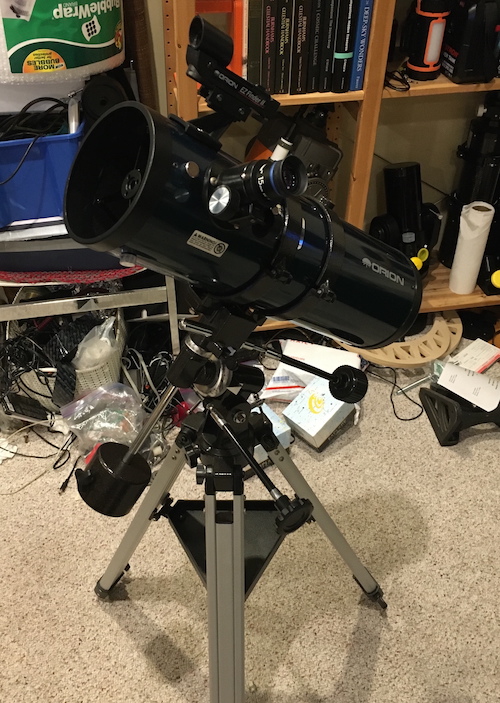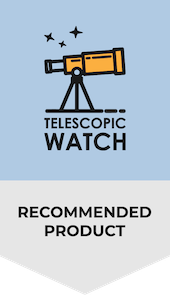The Optical Tube of Starblast 4.5 EQ

The StarBlast II EQ uses the same optical tube as Orion’s regular StarBlast Astro but it is supplied on Orion’s EQ-1 equatorial mount instead of a tabletop Dobsonian mount and comes with much better eyepieces.
The StarBlast is a 114mm (4.5”) f/4 Newtonian reflector. At f/4, there is some coma at the edge of the field of view with low-magnification eyepieces like the included 25mm Plossl, but even if you notice it, it shouldn’t hamper the image quality too much. The scope also requires precise collimation (which it thankfully has easy-to-use, spring-loaded adjustments for, unlike some other 114mm equatorial scopes on the market).
Orion doesn’t provide a collimation tool, but you can buy/make one or simply collimate it on a star—read our guide for more information on collimation.
About the Accessories
The StarBlast II EQ comes with two eyepieces: a 25mm Sirius Plossl (18x) and a 10mm Sirius Plossl (45x). You may want to purchase an additional 6mm “goldline” eyepiece (75x) as well as a Barlow or even shorter focal length eyepiece to get the most out of your StarBlast.
The StarBlast II is supplied with a red dot sight, which is adequate for this telescope. There’s also a moon map bundled with the scope (Orion’s MoonMap 260), which is essentially just a gimmick, and a smartphone adapter that will allow you to take shots of the Moon if you so desire-though forget serious astrophotography; that’s something for £1600 telescopes.
The Orion EQ-1 Equatorial Mount Quality
The EQ-1 mount is basically the same as the mount supplied with most of the Celestron PowerSeeker telescopes, but the StarBlast is small and light enough to work on it quite well – and also has good enough optics that it’s worth talking about actually using it.
The StarBlast II sits inside two felt-lined tube rings that bolt onto a Vixen-style dovetail plate, which in turn slots into a saddle on the EQ-1 mount head. This is an improvement over the older and lower-quality EQ-1 mounts, which just have rings bolted directly to the top; the StarBlast II itself used such a system until recently. Thanks to the universal dovetail plate and saddle design, you can theoretically swap any scope you want onto the EQ-1, and move the StarBlast II to any other (preferably more stable) mount you want.
The EQ-1 is more or less a simplified version of the larger German equatorial mounts used for large telescopes and/or astrophotography. It lacks a polar scope, and the setting circles on it are so small that they’re almost entirely useless, but for visual astronomy it works just fine—don’t expect it to work well for astrophotography, however.
Setting up and using the EQ-1 is pretty easy—just level the tripod, put the mount/scope together, balance the scope on both axes, and roughly line up the mount’s polar axis with Polaris. Coarse motion is achieved by simply pushing/pulling the scope around the sky while fine adjustments are made with the two included flexible slow-motion cables. If you need to rotate the tube to put the finder/eyepiece in a more convenient position, just slightly loosen the tube and rotate it in the tube rings (while being careful not to slide it forward/backward and ruin the balance).
What can you see?
The StarBlast II’s high-quality optics will show you Mercury and Venus’ phases, along with the dark albedo patches and ice caps on Mars. You can also see Jupiter’s cloud belts, the Great Red Spot and its 4 large moons. Saturn’s rings, the Cassini Division, the planet’s cloud belts, and about half a dozen of its moons are visible. Uranus and Neptune can be spotted as small turquoise and azure dots respectively, though locating them can be a bit tricky. Their moons are unfortunately too dim for the StarBlast to reveal.
Outside the solar system, the StarBlast excels at revealing large star clusters and nebulae. The Veil Nebula is easily visible with a good UHC or OIII filter. Orion, the Lagoon, and the Swan look excellent with even mediocre suburban skies. The scope can also pick up some of the brighter/larger galaxies such as M31, M51, the Leo Triplet, M81/82, and perhaps M101 and M33 with dark enough skies. You’ll even be able to spot planetary nebulae such as the Ring – a small donut-shaped fuzz that you might mistake for an out-of-focus star – the Dumbbell, the gorgeous blue NGC 2392, the Cat’s Eye, and the famous Blinking Planetary Nebula.
Alternative Recommendations
For similar prices to the Orion StarBlast II 4.5 EQ, there are a number of other scopes you might want to consider, including the following:
- Zhumell Z130 – Slightly larger aperture.
- Sky-Watcher Heritage 130P – Larger aperture, collapsible tube, and arguably superior included eyepieces.
- Zhumell Z114 – Same scope but on a tabletop mount, mostly at a lower price.
Due to constant price fluctuations, and discontinuations/reintroductions of many telescopes, we’d recommend you check out our “Telescope Ranking” page to get the most recent, and up-to date rankings and ratings of telescopes.
Aftermarket Accessory Recommendations
The most useful accessory we’d recommend for the StarBlast II is a 6mm “goldline” eyepiece which will provide 75x with the scope. This is a good magnification for viewing the Moon, planets, and double stars. A quality 2x Barlow will provide 36x and 90x with the stock eyepieces and 150x with the 6mm goldline, providing an even wider and more useful range of magnification.
Additionally, the EQ-1 is compatible with a motor drive. Celestron’s single-axis motor drive is designed for simple single-axis tracking. If you want to get fancy, the Orion EQ-1M unit (which costs a substantial portion of the price of the entire telescope) allows you to slew the telescope in right ascension back and forth with the push of a button, and adjust the rate for sidereal or lunar tracking speeds. The drive is battery-powered and will offer at least semi-accurate tracking.


